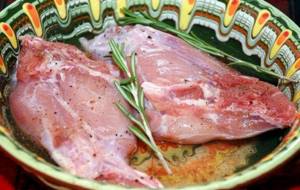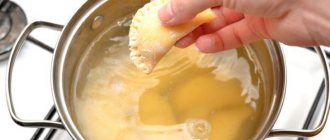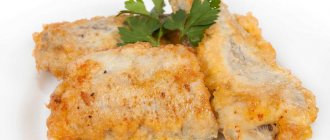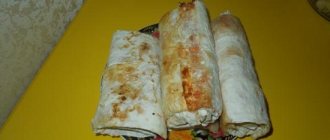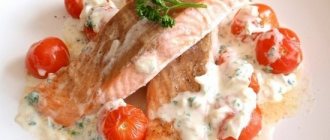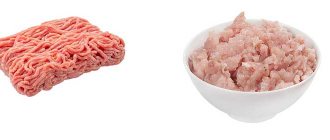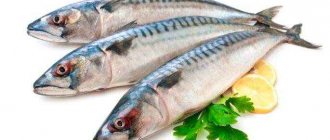07/17/2020 Pierre Gagnaire Cooking The calorie content of stewed rabbit is extremely low. Currently, there are a lot of different recipes that allow you to prepare juicy, tender and aromatic meat.
This article will discuss the most popular methods of stewing rabbit, as well as its calorie content and beneficial properties.
Chemical composition
The chemical composition of rabbit meat can be characterized as follows: a lot of protein (20-22%), little fat (10-11%), moderate content of purine bases and cholesterol. Rabbit meat is tender because it contains little connective tissue fiber. Thanks to this, it cooks quickly and is easy to chew.
Rabbit meat proteins contain nineteen amino acids, including all essential ones (indispensable for humans).
Essential amino acids
| Name | Content per 100 g, grams |
| Arginine | 1,5 |
| Valin | 1,1 |
| Histidine | 0,6 |
| Isoleucine | 0,9 |
| Leucine | 1,8 |
| Lysine | 2,2 |
| Methionine | 0,5 |
| Threonine | 0,9 |
| Tryptophan | 0,4 |
| Phenylalanine | 0,5 |
Of the essential amino acids, 100 g of this meat contains a lot of tryptophan (50% of the daily requirement), valine, isoleucine (45% each), leucine (40%), histidine and methionine (30% each).
Rabbit meat fats are represented by both saturated and unsaturated fatty acids (FA), which is a rare phenomenon for animal fat.
Composition of fats
| Name | Content per 100 g, grams |
| Saturated fatty acids | 4,9 |
| Monounsaturated fatty acids | 4,5 |
| Omega-3 | 0,4 |
| Omega-6 | 2,7 |
| Polyunsaturated fatty acids (except omega) | 0,8 |
| Cholesterol | 0,025-0,04 |
The ratio of saturated and unsaturated fatty acids in rabbit meat is almost ideal: it is 1:2. This proportion keeps fatty acids in a liquid state, which has a good effect on lipid metabolism in the body. Rabbit fat contains a lot of lecithin, a complex of phosphatides that exhibits an anti-cholesterol effect.
There are practically no carbohydrates in this meat product, so they do not play a biological role.
Among the vitamins in rabbit meat, vitamin B12 (140% of the daily requirement), nicotinic acid (up to 60%), pyridoxine and choline (25% each) are of great importance.
Vitamins and vitamin-like compounds
| Name | Content per 100 g, milligrams |
| Provitamin A (carotene) | 0,1 |
| Vitamin B1 (thiamine) | 0,12 |
| Vitamin B2 (riboflavin) | 0,18 |
| Vitamin B4 (choline) | 116,0 |
| Vitamin B6 (pyridoxine) | 0,5 |
| Vitamin B9 (folic acid) | 0,008 |
| Vitamin B12 (cyanocobalamin) | 0,0043 |
| Vitamin PP (nicotinic acid) | 12,0 |
| Vitamin C (ascorbic acid) | 0,8 |
| Vitamin E (tocopherol) | 0,5 |
The mineral composition of rabbit meat is also very rich: it contains many macro- and microelements in quantities significant for the human body.
The most important minerals are cobalt (160% of the daily requirement), sulfur and phosphorus (23-24% each), zinc and chromium (up to 20%), potassium and copper (about 15%). Mineral content
| Name | Content per 100 g, milligrams |
| Potassium | 340,0 |
| Sulfur | 225,0 |
| Phosphorus | 190,0 |
| Chlorine | 80,0 |
| Sodium | 55,0-59,0 |
| Calcium | 20,0 |
| Magnesium | 25,0 |
| Iron | 3,3-3,5 |
| Zinc | 2,3 |
| Cobalt | 0,162 |
| Fluorine | 0,075 |
| Manganese | 0,013 |
| Copper | 0,013 |
| Chromium | 0,009 |
| Molybdenum | 0,005 |
| Iodine | 0,005 |
Rabbit meat is a low-calorie animal product: its calorie content is about 180 kcal per 100 g.
Introducing rabbit meat into the diet of children
The optimal period for adding rabbit meat to the diet of children under one year of age is determined taking into account their health status. Our recommendations:
- If the baby is anemic or is bottle-fed, it is permissible to offer rabbit meat for the first time at the age of 6 months.
- For babies prone to allergies, the product should be offered as a first meat supplement - this is a better option than beef or pork.
- For babies who feed on breast milk and do not have health problems caused by a deficiency of nutrients, rabbit meat is added to the diet later: at 7-9 months - depending on the individual characteristics of the child.
You should not introduce rabbit meat into your child’s diet after vaccination, or during the period when he is sick. It is advisable to do this according to the following scheme:
- The first day - half a teaspoon of rabbit puree.
- Second day - a teaspoon.
- The third and subsequent days - gradually increase the portion to 30 g.
- 9 months - daily portion of rabbit meat up to 40 g.
- 10 months - up to 50 g.
- 11 months - up to 60 years
After a year, the baby can be given 60–70 g of rabbit meat per day. Not only the quantity matters, but also the cooking technology. At a very early age (6 months), special baby food is best absorbed. The meat in it is thoroughly chopped and is a homogeneous mass.
At first, the baby is accustomed to a one-component puree made from rabbit meat, but gradually you can move on to a combined puree, with the addition of vegetables or porridge. Later, when the baby has teeth, you can give dishes made from minced meat: cutlets, meatballs or soup with meatballs. Meat should be offered in pieces after a year, when the baby learns to confidently handle lumps of food.
Beneficial features
Tasty, low-calorie and easily digestible rabbit meat has many beneficial effects on most organs and systems of the human body.
When regularly present in the diet, rabbit meat affects the cardiovascular and hematopoietic systems:
- reduces the concentration of cholesterol in the blood;
- improves vascular elasticity;
- dilates peripheral blood vessels;
- increases the tone of the venous walls;
- helps reduce blood pressure;
- reduces the permeability of vascular walls;
- restores damaged intima of arteries and veins;
- normalizes blood viscosity;
- improves myocardial oxygenation;
- helps increase hemoglobin levels.
Rabbit meat has a stimulating effect on the digestive organs:
- accelerates the restoration of cells in the mucous membranes of the digestive tract;
- promotes the secretion of pancreatic juice;
- reduces the viscosity of bile, thereby preventing congestion in the bile ducts and bladder;
- increases bile secretion;
- normalizes intestinal motility.
Rabbit meat contains much fewer allergens than other types of meat, so it can be consumed by people with multiple food allergies.
Proteins, fatty acids, vitamins and minerals of rabbit meat are beneficial:
- children;
- pregnant women;
- women who are breastfeeding;
- elderly people and old people;
- convalescent;
- during severe and long-term illnesses;
- with weakened immunity.
The low calorie content of rabbit meat allows it to be included in the diet of obese people and those on diets.
How to butcher a rabbit
The majority of recipes involve the use of rabbit in portioned pieces, and this meat is sold exclusively as a carcass, but there is no reason to worry. Anyone who has ever cut up a chicken on their own will not experience any particular difficulties; the principle of operation is completely identical. Plus, once you try cutting a rabbit into pieces once or twice, you'll understand the general rules and won't have any more doubts.
First of all, you will need a comfortable and sharpest kitchen knife - without this condition, cutting up a rabbit will turn into a long and painful process of mockery of the carcass and your patience. However, as soon as you have a good quality tool in your hands, things will go smoothly and easily. By the way, in some places you can help yourself with ordinary poultry scissors, but keep in mind that they will make the task easier only if you are confident in handling this device.
In addition, you will need a thick cutting board for meat.
Seven simple steps to cutting up a rabbit into portions:
- The first step is to separate the back part of the carcass just above the place where the paws are attached (with a knife we make an incision up to the spine, we find the junction of the vertebrae and, by sharply pressing the knife, we separate one part from the other, after which we finish what we started with a knife; if you wish, you can separate the vertebrae using kitchen scissors ).
- We cut the separated back part in half into two paws.
- We divide each resulting “part” into a thigh and a lower leg, cutting along the joint.
- The middle part of the rabbit carcass must be cut crosswise into oblong pieces about 3-4 cm wide.
- Around this stage, it is worth carefully cutting out the insides if you received an uneviscerated rabbit - liver, kidneys, heart.
- We cut the remaining part of the carcass in half along the ridge. From the resulting pieces, cut off parts with ribs - the width of the fragments should not exceed 3 cm.
- After this, similarly to the hind legs, we divide the front legs into parts - into thighs and shins.
If you come across a rather fatty rabbit carcass, you can carefully trim off the excess and use it for subsequent frying.
Ready! It's really nothing complicated, isn't it? If you haven’t bought a rabbit before this day, hesitant about the upcoming task of butchering it, you should cast aside doubts and just try - you will certainly succeed!

Harmful properties

It is rare to be allergic to rabbit meat, but some people do develop it. If you have an allergic reaction to rabbit meat, its consumption is prohibited.
In terms of the content of purine bases, rabbit meat is the “anti-leader” among all types of meat: it contains the smallest amount of them - 38-40 mg of purines per 100 g. For comparison, there are 48 mg in 100 g of veal, and up to 70 mg in 100 g of pork. . Therefore, rabbit meat is the type of meat that is allowed in small quantities for patients with gout, but not more than three to four times a month.
Due to the purine content, children with hyperexcitability of the nervous system and those with a neuro-arthritic type of constitution (diathesis) should limit the amount of rabbit meat consumed.
The consumption of rabbit meat by patients with psoriatic dermatitis should be limited to two to three meals per week. At the same time, it must be cooked without fat, that is, by boiling or steaming.
Fried
Meat parts of a rabbit carcass are used for frying, although there are fans who like to tinker with small bones. Before frying, you need to keep the carcass in the marinade. There is no need to look for complex ingredients here. Needed:
- sparkling water - approximately 1.5 l;
- salt – 5...8 g;
- chopped onion, about two heads 70...90 g each;
- rabbit carcass from 1.5 kg and more.
All ingredients are placed in a saucepan. The minimum duration will be 2 hours, but not more than 6 hours.
It is advisable to use grill grates for frying. Cooking is done on a grill, where wood is pre-burnt or charcoal is lit. All you need is hot smoldering coals.
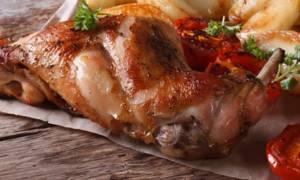
- Place foil on the bottom rack.
- Place the pieces of meat evenly.
- Cover with the top rack.
- They put it on the grill.
- Frying through foil is carried out for at least 20 minutes.
- Then the grill is turned over and the pieces are allowed to fry on the reverse side for 7...9 minutes.
- Leave on the coals for another 3...6 minutes, placing the grill with the foil down.
- Place the grill on a tray and remove the meat into a dish.
- Decorate with green onions, dill and parsley and serve.
Application in medicine
Considering the beneficial properties that rabbit meat exhibits on the human body, it is recommended to include it in the diet for various diseases:
- circulatory system (atherosclerosis, post-infarction and post-stroke conditions, arterial hypertension, coronary heart disease);
- digestive organs (gastritis, peptic ulcer, biliary dyskinesia, hepatitis, fatty liver, pancreatitis, colitis);
- metabolism (obesity, diabetes, protein deficiency);
- blood system (anemia, weakened immunity, pancytopenia);
- allergies.
It is useful to consume this meat product for patients suffering from dermatological diseases. Substances contained in rabbit meat accelerate the healing of wounds on the skin and improve its condition.
In order for rabbit meat to be beneficial and not show harmful properties in various diseases in humans, it must be prepared in gentle ways: boiling, steaming, stewing. Frying and baking rabbit meat increases its calorie content, increases the content of purine bases, destroys amino acids and vitamins, and oxidizes beneficial fatty acids.
For a couple
Steamed rabbit is prepared for sick people and children. A slow cooker will help you cook not only rabbit meat. At the same time, potatoes will be cooked in the resulting broth.

- The carcass is cut into portions.
- Place on a dish to season with salt.
- After allowing the salt to penetrate into the meat, they chop it into the multicooker basket.
- Pour water into the bottom of the device.
- Add peeled potatoes. The weight of the potatoes should be approximately equal to the weight of the rabbit meat.
- The water is slightly salted.
- Turn on the multicooker and leave for 40 minutes.
- After switching off, you get the most tender meat, as well as rabbit broth with boiled potatoes.
Rabbit is useful in all types of cooking. It makes excellent cutlets. During the period of mass slaughter, you can prepare stew, which is preserved in glass jars. You just need to hold it for at least 10 minutes at a temperature of 130 °C. Then it is guaranteed that no dangerous storage processes will occur.
Frozen rabbit carcass (at a temperature of -18 °C) can be stored for up to six months.
Outdoor use

Rabbit fat is used as a remedy for external use for various skin diseases (trophic ulcers, psoriasis, eczema, dry calluses, wounds, burns).
It is also used to enhance hair growth by mixing it with butter and honey in equal proportions and adding a clove of garlic. The freshly prepared product must be rubbed into the scalp. 60 minutes after application, rinse with warm water. After several procedures, the hair becomes stronger and begins to grow faster.
Stewed
Cooking the stewed rabbit must be done in a cauldron with a lid; a casserole dish or a massive enameled cast-iron cookware (saucepan) can be used.
- The carcass is cut into portions, approximately 40...70 g.
- Place on a tray or other dish, sprinkle with salt to soak the meat.
- Place the cauldron on the fire and pour in oil.
- Finely chopped onions are fried in vegetable oil (olive oil is preferred, but sunflower oil is also possible).
- Carefully add pieces of rabbit meat.
- Fry over high heat for no more than 7...8 minutes.
- Cover with a lid and place on the lowest heat.
- The stewing process lasts from 30 to 40 minutes.
- At the end you can add sour cream.

You can use boiled potatoes or buckwheat porridge as a side dish here.
How to select and store
When choosing a rabbit carcass on the market, you need to follow simple recommendations:
- you need to refuse to buy this product in spontaneous markets where there is no sanitary and veterinary laboratory and conditions for the sale of chilled meat;
- you should check for the presence of a veterinary stamp;
- carcass weight should not be less than 1100 g;
- the carcass must be completely bled;
- the surface of the meat should be moderately moist and elastic;
- There should be no foreign odors from the meat, except for the slight smell of fresh meat.
Fresh meat cannot be used for cooking: it must be ripe. To be sure of the ripeness of meat, after purchase it must rest for at least 8 hours in the refrigerator.
The shelf life of rabbit meat depends on storage conditions and is:
- in the freshness zone of the refrigerator at a temperature from 0 to +2°C - up to five days;
- in the refrigerator at a temperature from +2°C to +6°C - up to two days;
- in the freezer at a temperature of -18°C - 6 months;
- in the freezer in vacuum packaging at a temperature of -18°C - 10 months.
Baked
This is one of the easiest ways to cook rabbit. Usually the whole carcass is baked. Good restaurants use Italian-style ovens. Recently, it has been fashionable to bake meat in tandoors. Therefore, you should consider a similar recipe for making baked rabbit.
The carcass is placed in the marinade. It contains:
requires searching for complex ingredients. Needed:
- sparkling water - approximately 1.5 l;
- salt – 5...8 g;
- chopped onion, about three heads of 70...90 g.
You need to wait at least 3 hours. Fans of spicy food add crushed red pepper to the marinade.
- Light a fire in the tandoor and let the coals burn out completely.
- They leave only smoldering embers.
- Hang the carcass on a hook, and hang a small bowl from below to collect the draining juice.
- Cover tightly with a lid.
- The carcass is lowered into the tandoor and kept for 30 to 40 minutes.
- Open the lid and take out the baked rabbit.
- Serve on a platter or on a lyagan.
Use in cooking
Rabbit meat is a universal meat product in its preparation method. The rabbit is boiled, steamed, grilled, baked, fried, stewed, smoked.
Before heat treatment, rabbit meat is often marinated in sour cream, whey, vinegar, and white wine. The marinade prevents the meat from drying out during frying or baking. It goes well with seasonings:
- black pepper;
- oregano;
- bay leaf;
- thyme;
- celery;
- cloves;
- cinnamon;
- basil;
- parsley;
- dill;
- garlic;
- juniper.
Due to the fact that it contains a little of its own fat, rabbit meat can be prepared as both a dietary and high-calorie dish.
Diet bunny
To prepare it you need to take: half a rabbit carcass (preferably the front one), celery root, one carrot, two onions, salt and bay leaf. Small pieces of meat need to be poured with water, boiled over high heat and boiled until a large amount of foam appears. After this, drain all the liquid and wash the pan. Place the washed meat back into the pan, add boiling water, add salt and bring to a boil over low heat. Pour peeled and cut into strips vegetables into the boiling broth. Simmer over low heat for at least an hour. Before turning off, add bay leaf. You can serve with blanched broccoli or asparagus.
Non-diet rabbit in sour cream sauce
Best materials of the month
- Coronaviruses: SARS-CoV-2 (COVID-19)
- Antibiotics for the prevention and treatment of COVID-19: how effective are they?
- The most common "office" diseases
- Does vodka kill coronavirus?
- How to stay alive on our roads?
For this dish you will need: 0.5 kg of rabbit, a glass of sour cream and water, an onion, 2 tablespoons of butter, salt to taste, seasonings (turmeric, paprika, Italian herbs, white pepper). In a hot frying pan greased with butter, brown the rabbit pieces. Saute the onion, peeled and cut into rings or half rings, in butter in a separate frying pan until transparent. Mix sour cream with water, salt and spices to taste. Place the fried rabbit and onion in a saucepan, pour in the prepared sour cream filling. Simmer the dish over low heat for 1.5-2 hours (depending on the age of the rabbit).
Cooking method
So, the sequence of actions is as follows:
- We rinse the rabbit meat under cold water, dry it with paper napkins and cut it into longitudinal pieces.
- Peel and cut the carrots into thin strips.
- Remove the film from the onion and cut it into half rings.
- Rub the pieces of meat with spices.
- Heat a little sunflower oil in a frying pan and fry the rabbit until golden brown.
- Then add the onion and carrots and simmer for 5-8 minutes.
- Transfer the meat to a baking dish, add fried carrots and onions on top of it and sprinkle with spices.
- Pour hot water over the apple, remove the peel, cut into several parts, after removing the core and seeds.
- Place apple slices on top of the meat, pour sour cream over all the ingredients and lay out a bay leaf.
- Cover the pan with foil, press the edges tightly and place the dish in the oven for 55-65 minutes.
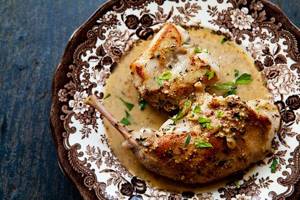
After the rabbit is ready, transfer it to a plate and garnish with finely chopped parsley or dill.
What are the benefits of rabbit meat?
Due to its many beneficial properties, rabbit meat can confidently be called the basis of the diet for the whole family. Treats made from this delicacy will benefit people of all ages.
For men
First of all, let's talk about the usefulness of this meat for the stronger half of humanity.
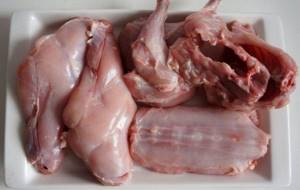
A well-digested and protein-rich product is indispensable for men in hazardous occupations and a similar lifestyle - pilots, firefighters, police officers, and those who have to work in places with an unfavorable environment, contaminated with radiation.
This delicacy is also very valuable for professional athletes.
For young and middle-aged men who do not suffer from long-term illnesses, the rate of consumption of rabbit meat is 3-5 times every 7-8 days. For a person over forty – 2–3. Regarding the daily norm, for men it is about 180 grams.
Important! Men should not buy rabbit meat in supermarkets, which receive it in large quantities. Enterprises for raising rabbits use various drugs (among other things, this is the female hormone estrogen)
Such “supplements” are quite harmful for men’s health.
For women
Women who are concerned about their figure are advised to choose rabbit meat from all types of meat. The reason for this is low calorie content. The daily norm for women is up to 150 grams.
However, keep in mind that rabbits up to three months of age are suitable for this task. Next, fat accumulates, calorie content increases, and, accordingly, the dietary value of the delicacy decreases.
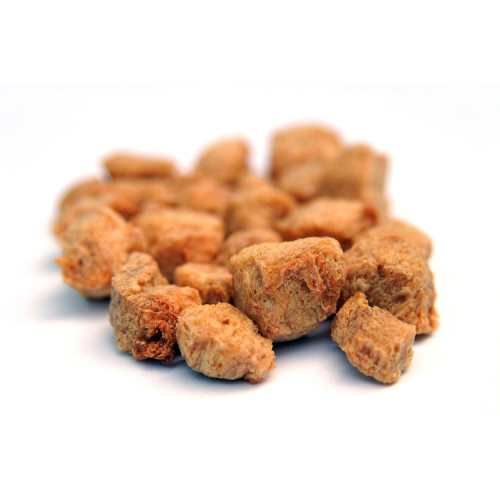
At the same time, the internal fat of this animal is a biologically active chemical substance and is used in the cosmetology industry. Fat-based creams and masks are popular among ladies.
Today there are many recipes by which you can create effective nourishing creams for hands and feet at home, for example, by mixing fat with honey in a 2:1 ratio. Rabbit fat can also be used undiluted as a cream.
For a child
Rabbit meat is not only good for children, it is perhaps the first meat that pediatricians recommend including in children's diets. They feed babies who are not even 7 months old. Baby meat puree is prepared from rabbit meat.
As you grow older, when all vital organs are formed, rabbit meat should also not be excluded from the menu. The full range of organic substances and minerals leaves no doubt about the usefulness of rabbit meat for a small organism. This low-calorie product contains neither antibiotics nor growth stimulants (especially if the carcass is homemade).
Important! This food in rare cases leads to neuroarthritic diathesis in children under one year of age. For your peace of mind, be sure to consult your doctor before introducing this product into your baby’s complementary foods.
What can you cook
Every housewife is free to cook rabbit meat according to the recipe that will satisfy the taste preferences of all family members. Chefs assure that this low-calorie product is difficult to spoil. Even regular broth turns out very tasty.
The light sweetness characteristic of rabbit meat goes perfectly with honey, dried fruits, vegetables (especially carrots), and cereals. The listed components are usually used in the preparation of stewed or baked dishes.
Rabbit meat is also fried, steamed or grilled. It is customary to serve various sauces with meat.
The type of meat in question makes delicious cutlets, meatballs, meatballs, soup, stew, and pate. The boiled delicacy is used in the preparation of salads and snacks. Broth or puree is best for a child.
